I have two horses with past driving experience that have been out of driving for about a year. I have been ground driving both. They both have issues with standing still after stopping. They also don't like stopping straight. I started them off with lounging and they turn in when stopping on the lounge. That seems to be part of the issue because they try to turn into me when ground driving. The rest is just impatientence, they paw, try turning, will do anything but stand still. One is particularly bad because he is barn sour and wants to get back. I've tried backing them up every time they step forward without being asked. But I have a terrible time getting them to back straight. Any ideas?
You are using an out of date browser. It may not display this or other websites correctly.
You should upgrade or use an alternative browser.
You should upgrade or use an alternative browser.
Whoa and standing still
- Thread starter Specialk
- Start date

Help Support Miniature Horse Talk Forums:
This site may earn a commission from merchant affiliate
links, including eBay, Amazon, and others.
Max's Mom
Well-Known Member
I've had a very similar problem, and will tell you what worked for us. Please note that the problem stemmed from the horse's anxiety and lack of confidence rather than him being sour or stubborn. Luckily, my daughter and I could work together on this, which really helped.
First, what didn't work: ignoring the problem and just trying not to have to stop or stand for very long, and only making him stand where we knew he would stand! (and yes, this was one failed approach we tried for a while!)
Second, what also didn't work: getting mad and trying to punish him for not standing, or using strong corrective or coercive techniques. This just served to wind him up and get him even more worried about standing. It also made him much more likely to try and spin!
What did work: One of us would ground drive while the other walked alongside his head. We would ask for a halt, and the header would be there to steady him and keep him straight. The header would also scratch his neck when he stood. We would halt him for only just a few seconds at a time, at first. This way, we could have a greater chance of having him be successful at standing still and being asked to move forward, rather than having him decide to move forward on his own. Once he could consistently stand still for 5 seconds without the handler having to "step in", we added time- 7 seconds, 10 seconds, 15 seconds... up to a couple of minutes. We also gradually walked further and further away from him, so that he would stop and stand straight without fidgeting without someone beside him or scratching him- and eventually with only the person driving him. This took time, but made the experience much more relaxed, and he began to learn that stopping and standing is not something to get worried about. I think the biggest thing is getting the timing right so that you are asking your horse to do something he is capable of doing successfully. If he won't halt without turning to you, that needs to be worked on until he can. And then, if he can stand for 10 seconds without pawing or lurching forward, start with asking him to stand for 10 seconds and then you ask him to move forward, rather than trying to make him stand for 5 minutes and fighting with him the whole time.
Good luck!
First, what didn't work: ignoring the problem and just trying not to have to stop or stand for very long, and only making him stand where we knew he would stand! (and yes, this was one failed approach we tried for a while!)
Second, what also didn't work: getting mad and trying to punish him for not standing, or using strong corrective or coercive techniques. This just served to wind him up and get him even more worried about standing. It also made him much more likely to try and spin!
What did work: One of us would ground drive while the other walked alongside his head. We would ask for a halt, and the header would be there to steady him and keep him straight. The header would also scratch his neck when he stood. We would halt him for only just a few seconds at a time, at first. This way, we could have a greater chance of having him be successful at standing still and being asked to move forward, rather than having him decide to move forward on his own. Once he could consistently stand still for 5 seconds without the handler having to "step in", we added time- 7 seconds, 10 seconds, 15 seconds... up to a couple of minutes. We also gradually walked further and further away from him, so that he would stop and stand straight without fidgeting without someone beside him or scratching him- and eventually with only the person driving him. This took time, but made the experience much more relaxed, and he began to learn that stopping and standing is not something to get worried about. I think the biggest thing is getting the timing right so that you are asking your horse to do something he is capable of doing successfully. If he won't halt without turning to you, that needs to be worked on until he can. And then, if he can stand for 10 seconds without pawing or lurching forward, start with asking him to stand for 10 seconds and then you ask him to move forward, rather than trying to make him stand for 5 minutes and fighting with him the whole time.
Good luck!
I am still trying to work through my geldings stopping and standing problems, even though he is dead quiet, he does not want to stand still very long nor does he want to stand straight; He tries to pull the sideways step routine if he cant get away with the forward moving. I feel your frustrations.
paintponylvr
Well-Known Member
Also, you can start with just leading with his harness on. You can practice the walk (lead), halt and stand when you lead him properly from his left side. Then switch sides and practice the same thing leading him from the right side. If your horse can't lead and halt quietly while on a lead line (draped loose), he'll never stop and stand quietly while ground driving.
Next step - while you are leading him ( you can handle the drive lines or not, your choice), ask him to step up and walk on while you drop back by his shoulder/withers. Then ask for your halts that way - with him standing slight ahead of you. Practice it from the right as well.
with our most up-tight mare, we spent hours (months!) - leading her asking her to stand with her head in the corner, stand w/ her head in front of the fence or to stand facing the barn wall or horse trailer. We also spent a lot of time leading and ground driving her - even after she was going in harness - with a "block" in front of her. When we'd stop/halt, we'd practice touching her (before blinders went on and also after we used blinders) and tugging on the harness. And when we got to the point where we were ground driving her, we'd often halt and then move to one side or the other and fiddle with the harness. They do learn. It takes time. When we started hooking her and we went to our driving lessons, sometimes she'd not want to make a turn and the instructor would step in and head her and lead her up where she needed to be/go and we'd continue. We went thru this a lot coming around part of his barn/trailer - of course - when continuing down the drive would have put us out by our trailer in the field away from the barn. We also did the technique of working pretty hard around the triailer or where she wanted to go and then going where I wanted to go to stand quietly and "blow" (breath for a while). I chose a specific "break point" and that was where we stopped for rest each time. That spot got further and further away from where she wanted to be.
If you haven't done so already - introduce obstacles that he has to step on, thru or over. After working thru rushing thru or over or jumping it until he walks only, ask for that all important stop. Count 1. Walk off, thru, over etc. Continue until he will stand for as long as you ask...
I was the one not prepared for this one - it caught me by surprise when my instructor got her to step into it and stand there. O - and notice that he is doing a combination of ground driving from the bridle, bit and lines and leading.
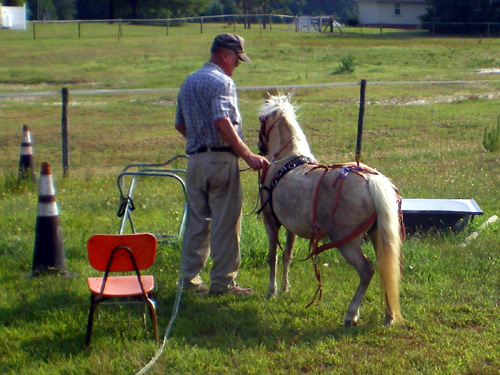
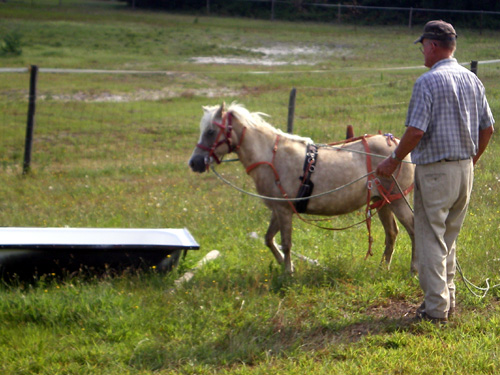
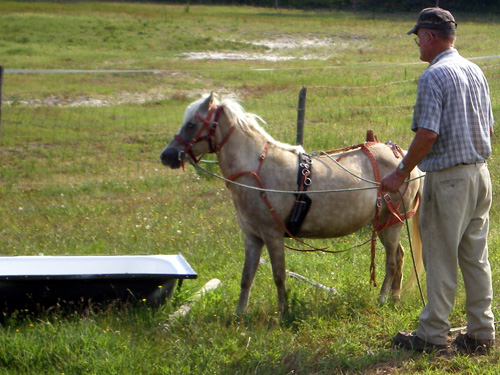
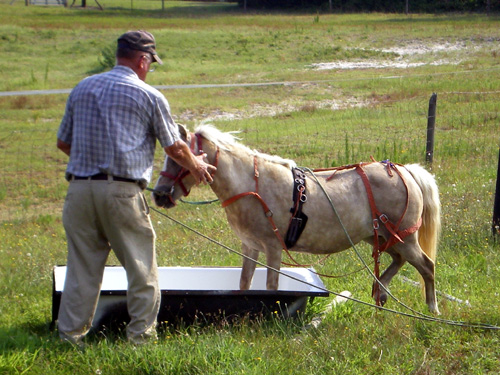
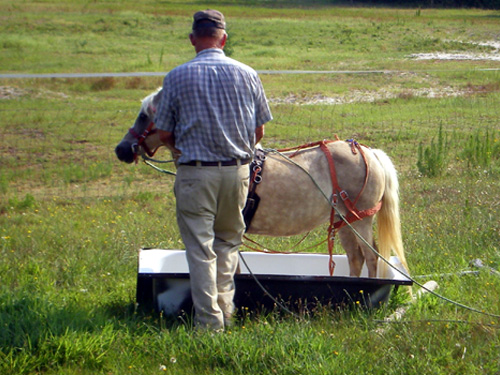
Obstacle work - including stepping into this tub or into a box or into a toddler swimming pool or onto a tarp, bridge etc teaches many things. Teaches them to slow down and relax, patience, to pay attention to what's under foot. Teaches you to slow down, take a breath and relax, work to teach your horse something new and so on.
I had started combo ground driving and lounging her in January. She was already trained to ride - both while led and off line in the round pen (her rider didn't graduate from the round pen before they moved to another state). She didn't like to stand still that way either - often spent time tied to a post or the trailer while I worked with his brother on a different pony or with his two step sisters on theirs. The above pics were taken in June.
This is her 3rd hitch to the cart - where he stepped in to guide her around the turn for me. This is August 10th. It would have worked better if I hadn't let the lines go so slack, but I did release them because he took hold of her bit/line not the halter under her chin.
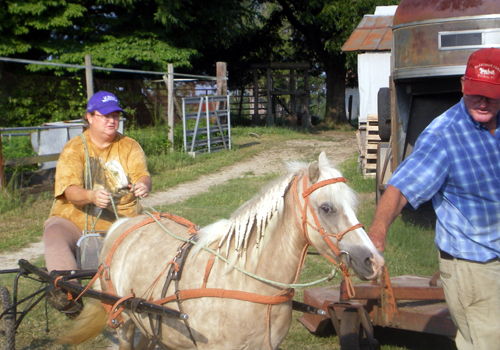
Next step - while you are leading him ( you can handle the drive lines or not, your choice), ask him to step up and walk on while you drop back by his shoulder/withers. Then ask for your halts that way - with him standing slight ahead of you. Practice it from the right as well.
with our most up-tight mare, we spent hours (months!) - leading her asking her to stand with her head in the corner, stand w/ her head in front of the fence or to stand facing the barn wall or horse trailer. We also spent a lot of time leading and ground driving her - even after she was going in harness - with a "block" in front of her. When we'd stop/halt, we'd practice touching her (before blinders went on and also after we used blinders) and tugging on the harness. And when we got to the point where we were ground driving her, we'd often halt and then move to one side or the other and fiddle with the harness. They do learn. It takes time. When we started hooking her and we went to our driving lessons, sometimes she'd not want to make a turn and the instructor would step in and head her and lead her up where she needed to be/go and we'd continue. We went thru this a lot coming around part of his barn/trailer - of course - when continuing down the drive would have put us out by our trailer in the field away from the barn. We also did the technique of working pretty hard around the triailer or where she wanted to go and then going where I wanted to go to stand quietly and "blow" (breath for a while). I chose a specific "break point" and that was where we stopped for rest each time. That spot got further and further away from where she wanted to be.
If you haven't done so already - introduce obstacles that he has to step on, thru or over. After working thru rushing thru or over or jumping it until he walks only, ask for that all important stop. Count 1. Walk off, thru, over etc. Continue until he will stand for as long as you ask...
I was the one not prepared for this one - it caught me by surprise when my instructor got her to step into it and stand there. O - and notice that he is doing a combination of ground driving from the bridle, bit and lines and leading.





Obstacle work - including stepping into this tub or into a box or into a toddler swimming pool or onto a tarp, bridge etc teaches many things. Teaches them to slow down and relax, patience, to pay attention to what's under foot. Teaches you to slow down, take a breath and relax, work to teach your horse something new and so on.
I had started combo ground driving and lounging her in January. She was already trained to ride - both while led and off line in the round pen (her rider didn't graduate from the round pen before they moved to another state). She didn't like to stand still that way either - often spent time tied to a post or the trailer while I worked with his brother on a different pony or with his two step sisters on theirs. The above pics were taken in June.
This is her 3rd hitch to the cart - where he stepped in to guide her around the turn for me. This is August 10th. It would have worked better if I hadn't let the lines go so slack, but I did release them because he took hold of her bit/line not the halter under her chin.

paintponylvr
Well-Known Member
I actually went from there and drove a lot for a while, but then she had a serious melt down (she was in heat and we were driving in a group with a stallion - drove her insane - he minded his manners) and in the kicking that ensued, she broke our cart in several areas. After, she was back to being jumpy and anxious and right back to not wanting to stop and stand. So my instructor helped again. The cart is full horse sized - she could not reach it to kick the circle bar apart if she tried.
He used a stall fork to keep her back and help remind her to slow down. First while leading her, then while "psuedo" ground driving her and then leaving the rake behind and continuing to ground drive her. I couldn't handle the lines and the rake at the same time, but I did use the whip to put in front of her chest while ground driving - by the time I ground drove her, it worked well enough. Later I got into the cart and drove her again from the seat... Not conventional, probably not recommended by any driving trainers (safety) but it sure did work! In almost just the one session. This was the Tuesday after our Sunday meltdown in late sept/early oct.
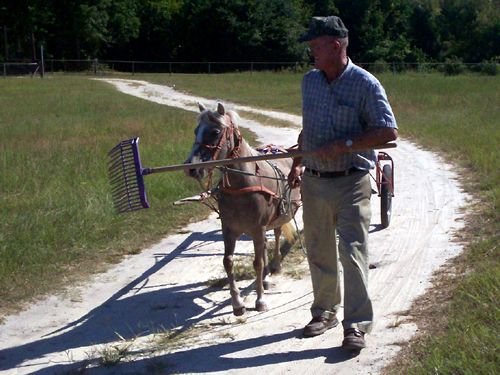
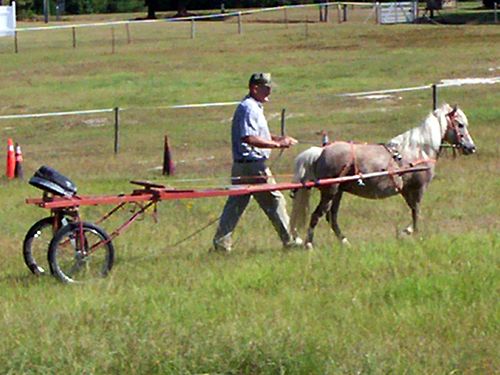
And this is May 2011 - new harness, new type of job (lots of single AND pair driving) and we STILL practice standing still in harness in front of the barn. Both facing away from it -
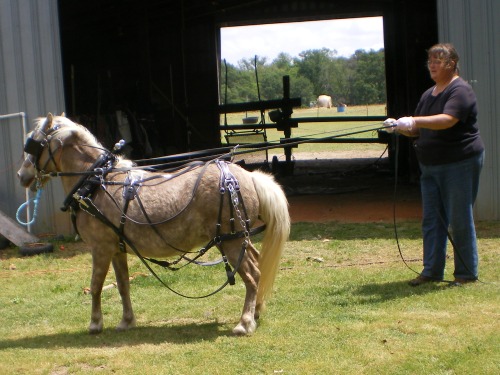
and facing towards the open door which she'd like to go through - notice the lines are slack here...
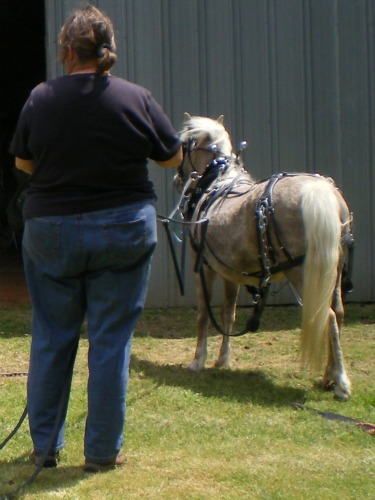
and doing a little work a little over a year after we started training to drive...
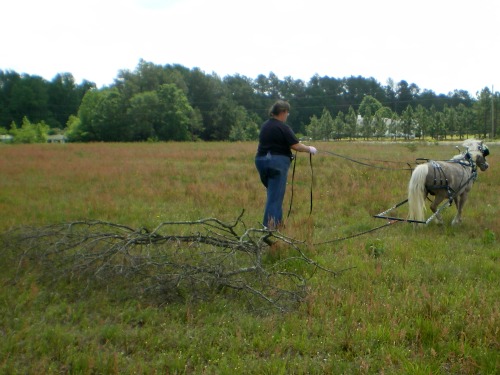
and in November 2011 - driving quietly out on the road. Not completely by herself - her driving partner is being driven as a pair with the wagon in front of us with another "new" driver. We did "indian drills" - going around the wagon and leading, driving beside it when no traffic coming and then behind it - like in this pic. She did GREAT!!
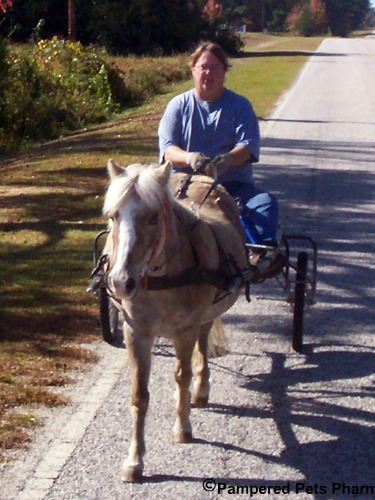
So... time. There are a lot of stories about this mare floating around here on this forum. I participated in the Training thread - and it got crazy for a while... They do get there - even when they dance and turn constantly in the beginning.
He used a stall fork to keep her back and help remind her to slow down. First while leading her, then while "psuedo" ground driving her and then leaving the rake behind and continuing to ground drive her. I couldn't handle the lines and the rake at the same time, but I did use the whip to put in front of her chest while ground driving - by the time I ground drove her, it worked well enough. Later I got into the cart and drove her again from the seat... Not conventional, probably not recommended by any driving trainers (safety) but it sure did work! In almost just the one session. This was the Tuesday after our Sunday meltdown in late sept/early oct.


And this is May 2011 - new harness, new type of job (lots of single AND pair driving) and we STILL practice standing still in harness in front of the barn. Both facing away from it -

and facing towards the open door which she'd like to go through - notice the lines are slack here...

and doing a little work a little over a year after we started training to drive...

and in November 2011 - driving quietly out on the road. Not completely by herself - her driving partner is being driven as a pair with the wagon in front of us with another "new" driver. We did "indian drills" - going around the wagon and leading, driving beside it when no traffic coming and then behind it - like in this pic. She did GREAT!!

So... time. There are a lot of stories about this mare floating around here on this forum. I participated in the Training thread - and it got crazy for a while... They do get there - even when they dance and turn constantly in the beginning.
This is a serious driving detail and must be addressed. What I am doing with my new one is working on the Stand while grooming, harnessing, and just working around him. I give the command to stand and use the whip to cue him if he moves even a hoof. Smack! on the ground by him. If he moves his whole body, I use the whip to move him back to his original position. No fudging. I smack him if I have to, being careful to stay below his head. This is serious and I mean business and he had better believe me.
While driving, first I try the pressure/release with the bit. We don't move forward until he is standing still. Sometimes we go around in a circle, but I persevere until he stands. Since he is learning, sometimes I will exit the cart and go to his head with my whip. Smack! on the ground in front of him. Usually that is enough to make him stand quietly. I know it is not ideal to exit the cart, but this horse is not a bolter and I keep a firm hold on the reins. If I return to get in the cart and he moves a hoof, I go back to his head and smack the ground again. I'm trying different things.
While driving, first I try the pressure/release with the bit. We don't move forward until he is standing still. Sometimes we go around in a circle, but I persevere until he stands. Since he is learning, sometimes I will exit the cart and go to his head with my whip. Smack! on the ground in front of him. Usually that is enough to make him stand quietly. I know it is not ideal to exit the cart, but this horse is not a bolter and I keep a firm hold on the reins. If I return to get in the cart and he moves a hoof, I go back to his head and smack the ground again. I'm trying different things.
FurstPlaceMiniatures
Well-Known Member
- Joined
- Mar 10, 2012
- Messages
- 607
- Reaction score
- 337
What worked with my old horse was the 'whoa and stand' command. If he was supposed to stand still (on the ground, etc,) I used that command. And I said it like crap was hitting the fan, so if it ever did and I got nervous, he just would think it was normal lol. I've been told my future kids are already afraid of my 'mom voice;' and it gets worse when I'm stressed. Didn't want my horse to find that weakness of mine!
While in harness, and anytime with horses, expect a lot, accept a little, reward the slightest try. At first all I would ask for is 2 seconds of standing. Set them up to win. Then build it up to 5; then 10; then 30; then eventually 30 minutes.
While in harness, and anytime with horses, expect a lot, accept a little, reward the slightest try. At first all I would ask for is 2 seconds of standing. Set them up to win. Then build it up to 5; then 10; then 30; then eventually 30 minutes.
paintponylvr
Well-Known Member
What worked with my old horse was the 'whoa and stand' command. If he was supposed to stand still (on the ground, etc,) I used that command. And I said it like crap was hitting the fan, so if it ever did and I got nervous, he just would think it was normal lol. I've been told my future kids are already afraid of my 'mom voice;' and it gets worse when I'm stressed. Didn't want my horse to find that weakness of mine!
Sorry, that is hilarious!!! Never thought of it that way, but you are right and that is a great way for some folks to get their horses used to such a procedure. I might have to try that - though when I think about it - I already sort of do that, LOL! I actually work hard to keep my "low, calm" voice - think my horses know my "drill sergeant" voice!
**********
When I taught riding, I really worked on an emergency stop - in several different ways - for folks that were overly fearful. That way they developed confidence in their ability to "stop" - so there was less panic. It wasn't always easy to do. I have found that the only way to stop from a faster gait - is to practice at that faster gait (!
It does work similarly with driving - yet it's different.
I do a lot of "whoa, stand" work before ever hitching - because that works for me. It is just not fun having one that doesn't stand calmly and I want to enjoy my driving. I have a whole group of youngsters that will be getting that type of work this summer. We've already started working on it with them - whenever they are haltered and led about. Soon, will be introducing line driving and will try to get some pics of what I'm doing to prevent that turn and spin "thing" - though a lot of that can be stopped by simply also getting your horses used to you moving around them while they aren't tied.
**********
If you are working by yourself all the time and still having them spin and face you - here is another exercise. Put on your training/driving gear but leave your horse (s) tied up. Then pick up the driving lines and step out to the side of the horse or even behind them. Pick up the lines, just a little bit of contact. If the horse moves around maintain that contact and say to them your command and as soon as the horse stands still for even a moment, release that contact and step in and pet them (or whatever reward you are using). Continue to practice this - from both sides and from the rear (standing directly behind them). Get to the point where you can step further away - continue practicing. When your horse will stay standing in position while you step to the rear, pick up the lines and contact, then release that contact and step back up to them - then it's time to untie them and do the same exercises w/ them not tied. THEN, ask for a step out and a halt (preferably with the fence still right there - so you can face them to the fence if you need to - just like they are tied). This is not a one time thing - it is a technique/training exercise that you build on and it could take a while to achieve (days/weeks/months? - depending on you/your horse). But it is another exercise that lays a foundation for standing in one spot while you move around your horse. You have to be able to move around your horse while hitching, while fixing/adjusting harness and of course it will also work to teach them not to turn and face you when you stop.
Also, set up a "rein board" to practice handling the lines. This will help A LOT when trying to sort thru the "mess" of long lines when your horse wants to spin towards you. Part of maintaining the "not spinning" is to have even, consistent pressure on both lines and to counter a loose line when a horse tries to turn on it's own. You don't usually drive with any slack in the lines but a constant, light "contact". Later, you can teach your horse to drive with some slack lines, but I don't recommend driving out in public that way - you have lost more than 1/2 your communication when you have slack lines... and it can take too long to gain your contact back if something goes wrong.
Last edited by a moderator:
Similar threads
- Replies
- 7
- Views
- 597
- Replies
- 7
- Views
- 365
Latest posts
-
We are finally getting somewhere!
- Latest: HeritageHollowFarm
-
-
-
Getting foal in position or Stage 1
- Latest: LostandFound
-
-
-
-
-


